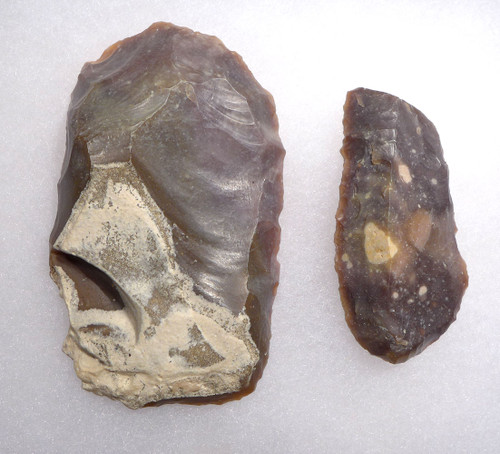Product Description
SEE MORE EUROPEAN NEOLITHIC TOOLS
Masterfully crafted between 5500 and 4500 BC, this stunning gray flint point scraper is so well made with a prominent base, it was likely hafted onto a wood, ivory or bone handle and used as a dagger or knife. It was found in Brittany, France and is attributed to the Linear Pottery Culture that lived in the area during this time. This milestone in European human history represents a major event in the initial spread of agriculture in Europe.
While many Neolithic flint flake tools are rather simplistic in design and were intended for simple, mundane purposes, this is one of the most refined and aesthetic Neolithic flint scrapers we have seen indicating its importance in its day. Original ground minerals and sediment are still intact in hinge fractures - an indicator ONLY seen in AUTHENTIC specimens.
HISTORY
Brittany has been inhabited by humans since the Lower Paleolithic. This population was scarce and very similar to the other Neanderthals found in the whole of Western Europe. Their only original feature was a distinct culture, called "Colombanian". One of the oldest hearths in the world has been found in Plouhinec, Finistère.
Homo sapiens settled in Brittany around 35,000 years ago. They replaced or absorbed the Neanderthals and developed local industries, similar to the Châtelperronian or to the Magdalenian. After the last glacial period, the warmer climate allowed the area to become heavily wooded. At that time, Brittany was populated by relatively large communities who started to change their lifestyles from a life of hunting and gathering, to become settled farmers. Agriculture was introduced during the 5th millennium BC by migrants from the south and east. However, the Neolithic Revolution in Brittany did not happen due to a radical change of population, but by slow immigration and exchange of skills.
Neolithic Brittany is characterised by important megalithic production and sites such as Quelfénnec, it is sometimes designated as the "core area" of megalithic culture. The oldest monuments, cairns, were followed by princely tombs and stone rows. The Morbihan département, on the southern coast, comprises a large share of these structures, including the Carnac stones and the Broken Menhir of Er Grah in the Locmariaquer megaliths, the largest single stone erected by Neolithic people.
 US DOLLAR
US DOLLAR
 EURO
EURO
 AUSTRALIAN DOLLAR
AUSTRALIAN DOLLAR
 CANADIAN DOLLAR
CANADIAN DOLLAR
 POUND STERLING
POUND STERLING
























